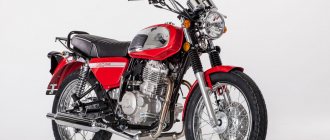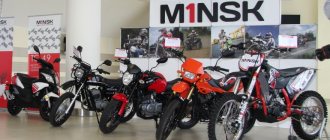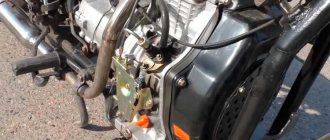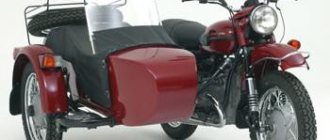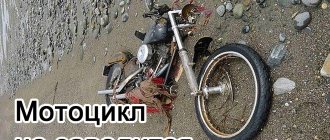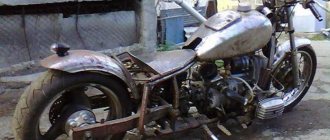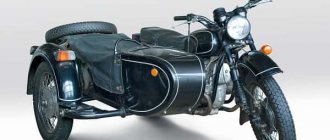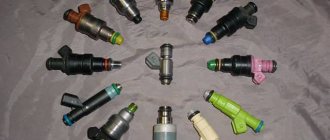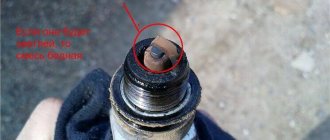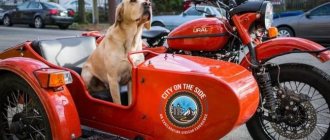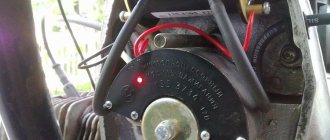Rate this post
Motorcycles "Dnepr" and "Ural" are known far beyond the borders of the countries of the former Soviet Union. At one time, technology created a buzz around itself due to its power and manufacturability. Dnepr motorcycles appeared back in 1950. The country's industry was in decline, so the government did its best to revive many enterprises that could produce tractors, combines, and motorcycles. At the Armored Repair Plant No. 8 in the city of Kyiv, they decided to launch the production of motorcycle equipment. A few years later, the plant was renamed the Kiev Motorcycle Plant, where the production of Dnepr motorcycles was launched. Motorcycles were in enormous demand and popularity, but what was their main success?
Which Dnepr models are the most common?
In the 50s, the plant began preparing the first heavy motorcycle for mass production - the M-72. This motorcycle had a 22-horsepower engine and weighed 330 kilograms. The maximum speed of the M-72 was 95 km/h. This model is considered the prototype and sample of the Dnepr series motorcycles. The K-750 model and the improved modification K-750M have become closer to the same “Dnepr”. This version, in comparison with the K-750, was distinguished by the presence of 4 additional horsepower and fuel consumption per hundred reduced by 1 liter. A durable engine paired with a gearbox is one of the main advantages of the motorcycle.
At the end of the 60s, the plant introduced a model that was later destined to become legendary - the K-650 or simply MT-8. The disadvantage of the K-750 and K-750M was considered to be an insufficiently reliable crankshaft. Defects formed on its surface after 20 thousand km. On new models, there was no damage to the crankshaft even after 40 thousand km. The plant’s engineers used all the innovative solutions available at that time, due to which they managed to increase the service life to 1000 operating hours.
But the most popular model among local motorcyclists is the MT-9. In just three years, the plant sold over 200 thousand km. There have been no global changes in this motorcycle compared to the MT-8: the same power rating, 27-horsepower engine, maximum speed of 100 km/h and weight of about 315 kg. This is the first MT series motorcycle to receive a turn signal.
The manufacturer focused its main efforts on increasing the comfort of the motorcycle and reducing fuel consumption to an acceptable level. For a long time, the developed design, which had proven itself in practice from a positive point of view, remained unique and unchanged. The following motorcycles MT-10 and MT-10-36 were not much different from each other. The only thing is that the MT-10-36 was equipped with an even more powerful 36-horsepower engine and increased the comfort of driving the motorcycle.
Disadvantages of the model
- High fuel consumption.
- The oil system has flaws.
- Difficulties in setting up the synchronization of the operation of two carburetors, which affects fuel consumption.
- The stroller shakes quite a lot when driving off-road.
Dnepr 16 ceased production in 1992. The motorcycle was very popular among residents of rural areas due to its good cross-country ability, as well as the ability to carry large loads. Despite the fact that the maximum load specified by the manufacturer is 270 kg, exceeding this weight had virtually no effect on the performance of the motorcycle.
Unfortunately, due to age, the motorcycle has lost its original qualities and it is quite difficult to resurrect this model. In addition, high fuel consumption and the need to devote a lot of time to repairs and maintenance discourage many from purchasing this equipment.
Decline of Dnepr motorcycle production
In the 80s and 90s, the plant produced only a few new models, the most common being the MT-16. This is the first civilian heavy motorcycle with an overhead valve engine and a sidecar wheel drive. In fact, all subsequent models underwent spot changes: a new ignition switch, an upgraded dry filter and an improved carburetor. In 1992, the last Dnepr motorcycle from the Chopper series was released. In 2000, the plant’s management attempted to revive production, and even developed a special modification “Dnepr” for export. But the project was quickly abandoned, without establishing mass production of the new heavy motorcycle (about 30 copies were produced in total). Thus, the legendary Dnepr has gone down in history forever, because the chances of reviving production are virtually zero. The plant was converted into a business center, and all equipment was handed over to a scrap metal collection point.
A trip on the Soviet "Dnepr" with a stroller replaces Dmitry's morning jogging
Share
Tell
Share
Tweet
Share
Some people are fond of collecting stamps, others go to the gym every day, and still others cannot live without Soviet motorcycles. We met with one of these people to create the “Garage” section. Meet Dmitry, the owner of the Soviet Dnepr motorcycle with a sidecar. He told us about his hobby and even took us for a ride in an unusual vehicle.
- This is the Dnepr from the Kyiv Motor Plant. I had a long series of meetings and partings with him. I owned it from 1998 to 2007. Then I sold it, and a few years ago I decided to return to it again. I decided to assemble a motorcycle with a sidecar. First we got the frame, the motor, then something else. He was a little different, and what you see now is an attempt to create an authentic image. I didn't paint it or do anything with the appearance of the bike, I just wanted it to ride and look the way it is. But this is quite difficult, because domestic technology requires selective assembly, correct application of hands and individual fitting of parts.
It shows that this is a paramilitary modification. It is equipped with a stroller wheel drive, numerous brackets and mounts for typical equipment. The motorcycle was created for harsh operating conditions. In fact, the quality of production of equipment components for the army is really higher. I tried to find original parts, but even suitable wheels cannot be easily bought in a store. You have to look for it somewhere, make it, order it. Many thanks to my friends and all those people who helped me - without them this would not have been possible.
I was surprised, but its fuel consumption is quite low, about 6 liters per 100 kilometers. This came as a surprise to me. The curb weight of the motorcycle is about 400 kilograms, so you won’t be able to ride it - the maximum speed is 85 kilometers per hour.
I assembled the engine of this motorcycle in 2004-2006. This engine is very individual. It was quite difficult to search for all this; I had to go to St. Petersburg, Moscow, and I had to order something from the Kiev Motor Plant itself. In principle, a lot could be bought here, but you would have to wait a long time, and the price would be much higher. “Russian Post” did not work so quickly back then, there was no online trading at all. Therefore, I had to travel a lot myself, although tickets were cheap back then. You could go to Moscow for 400 rubles.
You need to get used to the controls. Still, a motorcycle with a sidecar wheel drive, albeit with a differential. In fact, it is a car without one front wheel. In general, it is quite stable. Even when you manage to put it into a skid, it somehow stabilizes itself.
How I started driving in winter. On December 28, I left the house, it was very slippery. I slipped and fell... and almost broke my leg, leaving a huge bruise. I was upset and thought that it’s probably not worth walking in this weather, it’s better to drive. I ordered tires in St. Petersburg, sent them to be studded, and now I’ve been driving since December 31st.
When you ride it on our roads, it shakes quite violently, it’s an old motorcycle, it has practically no loyalty to the driver. A trip in the morning is like jogging or gymnastics. Very invigorating.
I carry passengers in a stroller. People are happy, they say it’s great, some even then think about buying something similar for themselves. In our city there are many people who ride motorcycles with sidecars. I personally know four people who chose such a means of transportation in winter; there are more in summer.
Motorcyclists are quite a close-knit community. Many of them know each other. But if you attend some events, you will see that the owners of Soviet and imported motorcycles sometimes look at each other from a certain distance.
I have several friends - serious adults, with higher education, excellent specialists in their fields, but they prefer to ride Soviet motorcycles. They are doing well and they have a Soviet motorcycle because they like it. This is a technique that is interesting. Even the instructions for such motorcycles say: “The motorcycle is intended for cultural, business and tourist trips,” very intelligently. These motorcycles are a legacy of the era. That era when knowledge was power.
The modern motorcycle community is somewhat consumerist. Some people buy a motorcycle and immediately think about how they will sell it in order to also make money. People who buy Soviet motorcycles are forced to communicate closely with them; they will definitely need to repair, adjust, and improve something. It's not even a hobby, it's self-realization. People realize themselves in different ways, some with the help of domestically produced motorcycles.
Similar motorcycles are still produced in Russia. The Irbit Motorcycle Plant currently produces exclusively motorcycles with sidecars. At one time they existed in parallel with the Kyiv Motor Plant. One produced a few motorcycles for the police, and the other for the army. And then the USSR collapsed, and the Kiev Motor Plant did not survive. A new domestic motorcycle with a minimum configuration costs just over half a million rubles.
How do people react? Children pull their parents by the sleeve and rejoice: “Mom! Dad! Motorbike!" A motorcycle with a sidecar gives people delight. People are smiling. Me too. Even if it's cold.
Why did Dnepr quickly sell out?
If we take into account the design of the Dnepr motorcycle, then, for example, against the background of one of the main competitors - Ural - the equipment had several obvious advantages. First of all, this is a repairable crankshaft. The crankshaft was one-piece, with plain bearings on the lower heads of the connecting rods (the connecting rods were collapsible).
This production technology made it possible to experience several obvious advantages of the motorcycle:
- the possibility of repairing the connecting rod and piston group;
- possibility of restoring the crankshaft;
- increased service life of the liners due to their increased contact area with the shaft.
But this also has some disadvantages, for example, if the lubricant supply is stopped, the liners quickly “die”. There is still no clear answer to the question of which engine is more durable - the Ural or the Dnepr. With regard to the gearbox, the situation is somewhat different. The gearbox on the MT-804 model was particularly reliable and durable. This gearbox has clear and smooth gear shifts. Another advantage for which many motorcyclists chose the Dnepr is its high-torque performance. The brutal appearance also played a significant role in the popularity of the motorcycle. The “classic” double seat also found its admirers.
content .. 41 42 46 ..MAIN TRANSMISSION AND STROLLER WHEEL DRIVE MECHANISM FOR MOTORCYCLES “URAL”, “DNEPR” OFF-ROAD ROAD
Off-road motorcycles have an additional sidecar wheel drive. On a motorcycle. "Dnepr-16" has a sidecar wheel brake mounted on the right cover of the sidecar wheel gearbox, and a different design of the transverse driveshaft is used - the rigid pipe is replaced by a relatively thin steel rod.
The main gear with an asymmetrical cylindrical differential is designed on the basis of the main gear, which is used without a differential. Cardan transmission (Fig. 4.38),
The drive gear, bearings and housing are taken from the base model of the motorcycle. The cuff and its cover are the same. The left hub spline is the same as on the base model. All connecting dimensions of the main gear to the wheel remain unchanged.
A differential and a gearbox are attached to the crankcase, which form the main gear of the off-road motorcycle. The main gear is connected to the stroller wheel gearbox by a transverse cardan shaft with two rigid hinges. The differential consists of the following main parts: driven gear 8 and cup 25, which form the differential housing, two hubs 13 and 28 with ring gears, two wide 7 and two narrow 24 satellites and their 4 axles 5. The differential cup is connected to the conical driven gear gear using two bolts secured with bent washers and two pins pressed into the protrusions of the cup and freely entering the gear hole. These pins center the positions of the two parts. The differential parts are located in the crankcase 6 9 (Fig. 4.38). The right hub 28 ends with a splined rim on which the drive gear 29 of the gearbox is mounted, secured by a retaining ring 1. The drive gear is connected to the driven gear 27, the shank of which is connected through a cardan joint to a transverse cardan shaft, which goes to the stroller wheel gearbox. The housing parts of the main gear are connected through cardboard gaskets. Maintenance of the main gear and gearbox consists of monitoring the oil level and replacing it in a timely manner. The oil level is controlled by dipsticks with two lines, which indicate the maximum and minimum levels. The type of oil and the frequency of its replacement are the same as for the base model.
The universal joint bearings are lubricated with a syringe through grease nipples screwed into the crosspieces. To lubricate the bearings, you need to unscrew the caps using a radius wrench.
It should be remembered that the cap on the main gear side has a left-hand thread, and on the gearbox side it has a right-hand thread. The movable splined connection of the transverse propeller shaft with the universal joint fork on the main gear side is also lubricated.
Rice. 4.38. Main gear of a motorcycle with sidecar wheel drive: 1 — retaining ring; 2 - gearbox cover; 3, 14 — bushings; 4 - cover; 5 — satellite axis; 6 — differential housing; 7 - wide satellite; 8 — bevel driven gear; 9 — roller bearing; 10 — roller needle bearing; 11 — crankcase bushing; 12 - crankcase; 13 — left hub; 15 — bearing; 16 - bevel drive gear; 17 - nut; 18 — wedge bolt; 19 — cardan shaft; 20 - elastic coupling; 21, 31 — protective caps; 22 — cuff; 23, 26, 30 — ball bearings; 24 — narrow satellite; 25 — differential cup; 27 — small driven gear; 28 — right hub; 29 - drive gear
Rice. 4.39. Differential drive of motorcycles “Dnepr-11/16”: 1 - bolt, 2 - lock washer; 3, 17, 29 — rollers; 4 — satellite, 5, 11, 25 — bearings; 6 - ring; 7 - bearing nut, 8, 27 - oil seal seals, 9 - output gear; 10, 23 — washers; 12 — differential cup; 13 - idler gear; 14 — satellite axis; 15 — bushing; 16 — driven gear; 18 — retaining ring; 19 — right hub; 20 — spacer sleeve, 21 — needle bearing; 22 - gear; 24, 26 - oil seal springs; 28 — left hub
Rice. 4.40. Crankcases and differential covers of motorcycles “Dnepr-11/16”: 1.15 screws; 2 - cover; 3 - gasket; 4 — differential cover; 5 - gasket; 6 - gasket; 7 - plug; 8 — differential housing; 9 - gasket; 10 - nut; 11,21 - washers, 12 - pin; 13 - oiler; 14 — fist bushing; 16 — breather plug; 17 - dipstick; 18 - crankcase; 19 — bushing; 20 - bracket; 22 - bolt; 23 — oil seal spring; 24 — oil seal collar; 25 - oil seal cover
Rice. 4.41. Stroller wheel reducer: 1 — stroller wheel suspension lever; 2 — driven gear; 3,12, 14-ball bearings; 4, 8, 15 — cuffs; 5 - bushing; 6 — stroller wheel axle; 7 — cuff cover; 10 — right cover; 11 - drive gear; 13 — gear housing; 16 — wedge bolt; 17 — protective cap; 18 — cardan shaft; 19 - nut; 20 — left cover; 21 - gasket
Rice. 4.42. Gearbox with torsion shaft of motorcycles “Dnepr-11/16”: 1, 22 - nuts; 2 — special washer; 3 — stroller axle; 4, 9, 19, 31, 33 — bearings; 5, 27 — oil seal springs; 6, 26 - oil seal cuffs; 7 — bushing; 8 — driven gear; 10 - reflector; 11, 21 — cotter pins; 12 - pin, 13 - oiler; 14 — cardan shaft; 15 — cardan fork; 16 — cardan cross; 17 — cardan ring; 18 — ring clip; 20 — lock ring; 23 — washer; 24 — wedge bolt; 25 — cardan fork; 28 — gear nut; 29 — ring; 30 — adjusting washer; 32 — spacer sleeve; 34 - small gear; 35, 36 — seals; 37 — cardan cap
content .. 41 42 46 ..
Appearance
The Kiev plant decided to improve the appearance of the MT 10 36 motorcycle; technical characteristics now suggested the presence of levers at the end, the passenger footrests now reclined, and union nuts appeared on the exhaust pipes. Next, the manufacturer decided to improve the existing MT 10, the modernization took place in 1985 and received a number of changes in technical terms. Today you can buy MT 10 in the following sizes:
- length 2430 mm;
- width 1680 mm;
- height 1080 mm;
- wheelbase 1500 mm;
- ground clearance 125 mm.
Externally, the Soviet heavyweight was restrained and did not have a special design; then it was not customary to install plastic and other decorative elements; the main emphasis was on quality and simplicity of design.
It was in 1985 that the motorcycle received major changes; the MT 10 engine increased power from 32 to 36 horses. Since then, the device has become officially known as the Dnepr MT 10-36. In order to improve the motorcycle, the manufacturer began to produce it in accordance with GOST, as a result, safety was significantly improved and external noise was reduced. Safety has improved in particular due to changes to the front brake, which now has two pads. The use of clamps on gas hoses helped provide additional fire protection for the motorcycle.
Now the Dnepr MT 10 with a sidecar was used with a different oil change system. It is directly added to gasoline after each refueling. This helps directly provide lubrication to the internal components. Electrical equipment receives a huge advantage; the manufacturer was able to install self-oxidizing wires, which ensure stable and durable operation of all electrical devices. Also, a special wiring system made it possible to refuse the installation of other unnecessary devices.
The gearbox is set to 4 speeds, there is a reverse speed, and a dry clutch with two discs helps ensure smooth and sensitive shifting. At that time, all Soviet motorcycles were equipped with air cooling, so the MT 10 was no exception. The suspension of the motorcycle is of quite high quality, the excellent design makes it possible to get good handling on the road and cross-country ability over uneven terrain. In particular, this is due to the presence of a sidecar, which will prevent the motorcycle from turning over at high speed.
Despite the fact that the Dnepr motorcycle with a sidecar is no longer produced, many still actively use the existing samples. They show good quality, the engine is durable and easy to maintain. If desired, you can notice many changes in appearance and design, which is called custom Dnepr MT 10.
Technical characteristics of the motorcycle Dnepr MT 10
The main technical characteristics of a motorcycle are the engine performance. The engine is a four-stroke engine with two valves and two cylinders, the valves are located at the top. The new product was distinguished by the presence of good traction, which is provided by a volume of 649 cm3. Power was 36 hp. Fuel injection was made possible thanks to two K-301D carburetors.
Electricity was generated using an alternating current generator with a voltage of 12 volts. Moto Dnepr MT 10 had excellent torque, reaching 46 Nm. At maximum acceleration at high power, the bike reached up to 5,800 rpm. The kit included a rechargeable battery; if desired, you can add two batteries.
